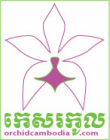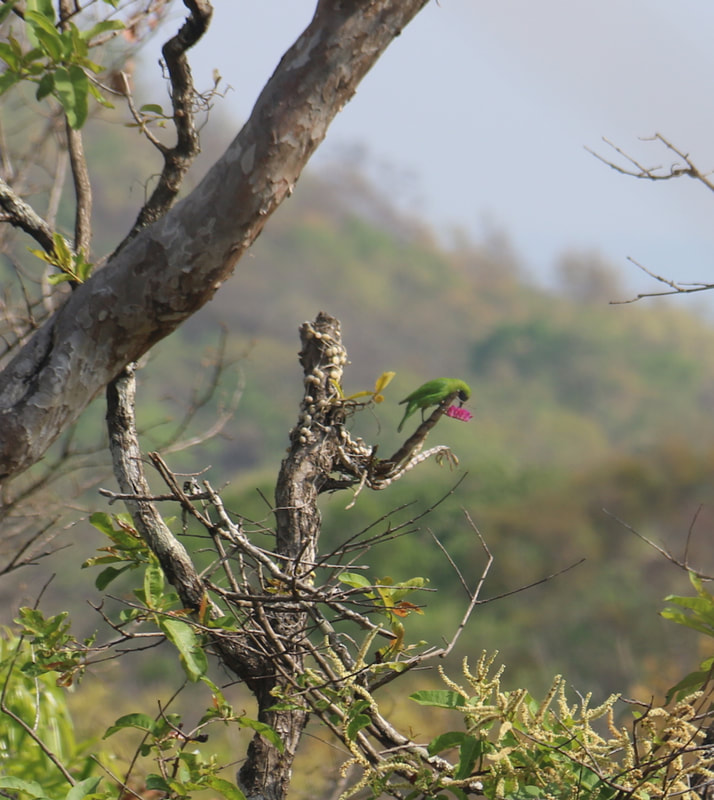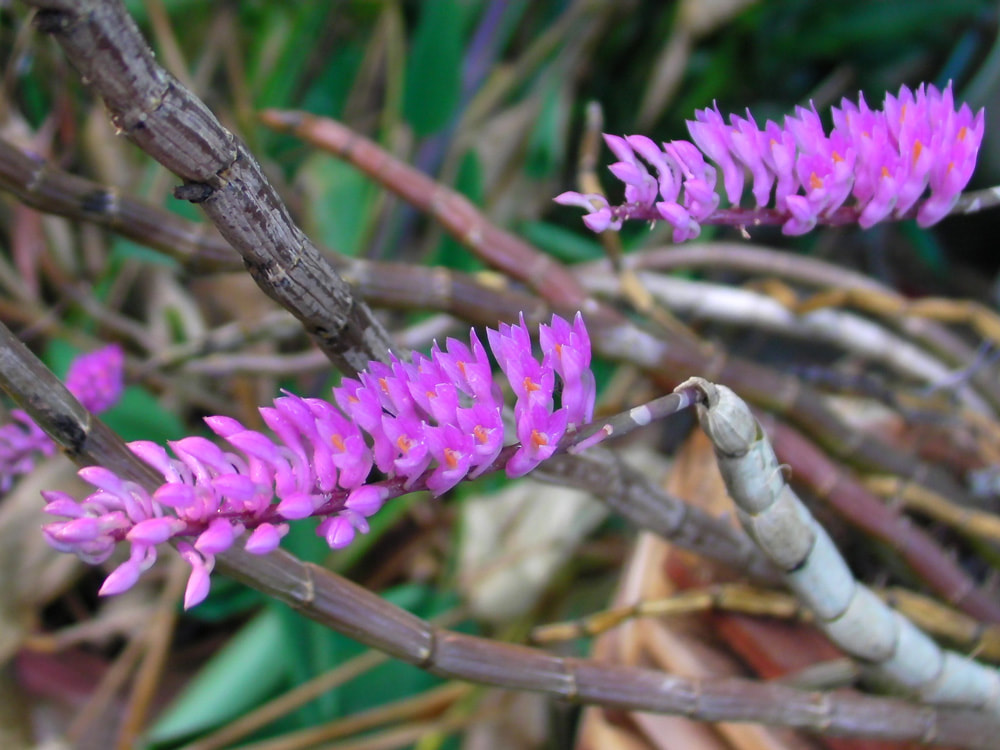The funny case of the Golden-fronted Leaf-bird and the Dendrobium secundum
The photo was taken by Vuthy Phan, in Mondulkiri, Cambodia, 2016.
The orchid is the distinctive Dendrobium secundum – also known as the ‘tooth-brush’ orchid.
A bird expert, Rob Overtoom, helped to identify the bird as a male Chloropsis aurifrons or more commonly known as the ‘golden-fronted leafbird’.
The documentation of orchid pollination by birds is rare and was previously documented in the region by Burkill in 1919 in Singapore (Cf.).This photographic evidence is an important sign that orchid pollination by birds is most likely taking place in Cambodia. There is a need for more documentation and substance to make a more definitive claim and perhaps this intrigue will inspire scholars and researchers.
For starters, Darwin reminds us with a short and simple phrase about evolution, that ‘what is considered useful is kept’. And so over millions of years, the relationship between species evolved. Some flowers seemed to have 'found it useful' to even mimic some insects. Orchids are famous for this. But they are not the only ones to have developed strategies. For example, you may be interested to watch this Mantis Orchid relationship.… This demonstrates rapidly that, while orchids have their own ‘strategies’, they are not alone. Each species is left to its own and has to devise both survival strategies and reproductive ‘plans’. These strategies and plans are unfolding all the time between all species, overlapping, complementing or conflicting with each other.
Therefore to make sense of the photo above, we need to take both the bird and the orchid perspectives and try to understand how these come together in this picture. For this, here is an enlightening excerpt from Van der Pijl and Dodson:
“What else makes an orchid good for birds?
1. Vivid colors
2. Absence of odor because birds lack the sense of smell
3. Small or curved-back flower lip since birds do not need to land on flowers
4. Abundant nectar in medium-length, rather broad tubes with a capillary system
5. Tubular horizontal flowers, often hanging free, with space for hovering birds
6. Hard flower walls with protected organs because of hard bird beaks
7. No nectar guides since they are not necessary for birds”
With this in mind, we can already refine our search and rule out some possibilities:
1. The Perspective of the golden-fronted leafbird:
-Is it a mating strategy ? Is the bird waiting to meet a companion like this female standing near other Dendrobium species? While this (and shyness) cannot be ruled out, on the photo at least, the male seems to show more interest in the flowers.
-Is the bird looking for food and if so… what kind of food?
This bird is known to go on orchid bananas binges and also eats fruits like berries, but it is unlikely to have mistaken orchid bananas for orchid flowers. Still flowers are a pretty easy spot to find insects, specially for this one. It is therefore possible that the bird is hunting for insects inside the flowers - and acts as pollinator by visiting other flowers.
-Is the bird collecting nectar?
The spiked tongues of the golden-fronted leafbird are well adapted for taking nectar from tubular flowers.
Like hummingbirds, they can hover in front of a flower while retrieving the nectar. Descriptions of the D. secundum resonate well with this bird’s view point: 'waxy glossy, fragrant tubular flowers that do not open well…on cane-like semi-pendulous and leafless stems’...perfect to land on. There is a strong lead here….
2. The Perspective of the Dendrobium secundum:
Orchids use flowers to reproduce. They need pollinators to carry their pollen between flowers. They have developed multiple ways to attract pollinators (flower shapes, colors, fragrances, pheromones…).
The D. secundum is a fragrant orchid – many orchids use the stratagem of smell and produce pheromones that mimic the smell of food or of the ‘opposite sex’ – but since birds have no sense of smell this strategy applies to insects and there is another problem…the D. secundum is not known to produce nectar. So the plot thickens...
Is the bird’s visit simply coincidental?
Can answers be found looking at the flowers? The D. secundum is known as the ‘Toothbrush orchid’ because of its perfectly lined and upward standing flowers. This is a distinctive feature. Its stems are also leafless when in flower, making it easy for birds to land and access the flowers.
While the shape of the flowers makes it unlikely for rain to penetrate, it is possible that the tubular shape is able to capture and keep mist water / dew and the bird could be attracted to drops of water kept in the flowers. Additional research could help answer some of these questions.
The photo was taken by Vuthy Phan, in Mondulkiri, Cambodia, 2016.
The orchid is the distinctive Dendrobium secundum – also known as the ‘tooth-brush’ orchid.
A bird expert, Rob Overtoom, helped to identify the bird as a male Chloropsis aurifrons or more commonly known as the ‘golden-fronted leafbird’.
The documentation of orchid pollination by birds is rare and was previously documented in the region by Burkill in 1919 in Singapore (Cf.).This photographic evidence is an important sign that orchid pollination by birds is most likely taking place in Cambodia. There is a need for more documentation and substance to make a more definitive claim and perhaps this intrigue will inspire scholars and researchers.
For starters, Darwin reminds us with a short and simple phrase about evolution, that ‘what is considered useful is kept’. And so over millions of years, the relationship between species evolved. Some flowers seemed to have 'found it useful' to even mimic some insects. Orchids are famous for this. But they are not the only ones to have developed strategies. For example, you may be interested to watch this Mantis Orchid relationship.… This demonstrates rapidly that, while orchids have their own ‘strategies’, they are not alone. Each species is left to its own and has to devise both survival strategies and reproductive ‘plans’. These strategies and plans are unfolding all the time between all species, overlapping, complementing or conflicting with each other.
Therefore to make sense of the photo above, we need to take both the bird and the orchid perspectives and try to understand how these come together in this picture. For this, here is an enlightening excerpt from Van der Pijl and Dodson:
“What else makes an orchid good for birds?
1. Vivid colors
2. Absence of odor because birds lack the sense of smell
3. Small or curved-back flower lip since birds do not need to land on flowers
4. Abundant nectar in medium-length, rather broad tubes with a capillary system
5. Tubular horizontal flowers, often hanging free, with space for hovering birds
6. Hard flower walls with protected organs because of hard bird beaks
7. No nectar guides since they are not necessary for birds”
With this in mind, we can already refine our search and rule out some possibilities:
1. The Perspective of the golden-fronted leafbird:
-Is it a mating strategy ? Is the bird waiting to meet a companion like this female standing near other Dendrobium species? While this (and shyness) cannot be ruled out, on the photo at least, the male seems to show more interest in the flowers.
-Is the bird looking for food and if so… what kind of food?
This bird is known to go on orchid bananas binges and also eats fruits like berries, but it is unlikely to have mistaken orchid bananas for orchid flowers. Still flowers are a pretty easy spot to find insects, specially for this one. It is therefore possible that the bird is hunting for insects inside the flowers - and acts as pollinator by visiting other flowers.
-Is the bird collecting nectar?
The spiked tongues of the golden-fronted leafbird are well adapted for taking nectar from tubular flowers.
Like hummingbirds, they can hover in front of a flower while retrieving the nectar. Descriptions of the D. secundum resonate well with this bird’s view point: 'waxy glossy, fragrant tubular flowers that do not open well…on cane-like semi-pendulous and leafless stems’...perfect to land on. There is a strong lead here….
2. The Perspective of the Dendrobium secundum:
Orchids use flowers to reproduce. They need pollinators to carry their pollen between flowers. They have developed multiple ways to attract pollinators (flower shapes, colors, fragrances, pheromones…).
The D. secundum is a fragrant orchid – many orchids use the stratagem of smell and produce pheromones that mimic the smell of food or of the ‘opposite sex’ – but since birds have no sense of smell this strategy applies to insects and there is another problem…the D. secundum is not known to produce nectar. So the plot thickens...
Is the bird’s visit simply coincidental?
Can answers be found looking at the flowers? The D. secundum is known as the ‘Toothbrush orchid’ because of its perfectly lined and upward standing flowers. This is a distinctive feature. Its stems are also leafless when in flower, making it easy for birds to land and access the flowers.
While the shape of the flowers makes it unlikely for rain to penetrate, it is possible that the tubular shape is able to capture and keep mist water / dew and the bird could be attracted to drops of water kept in the flowers. Additional research could help answer some of these questions.
3. A twist in the relationship: the Erythrina orientalis
Most interestingly, the Chloropsis aurifrons is particularly attracted to flowers that look nearly the same shape and size as Dendrobium secundum, with a similar shaped inflorescence, particularly the flowers from trees, such as Erythrina fascia, that is common in Cambodia. The ressemblance with the D. secundum is striking both in shape but also in vibrance with species such as the Erythrina orientalis. The flowers of D. secundum are a unique vibrant-pink color and this differs from the reddish colors of the flowers of the Erythrina.
But humans and birds see things quite differently. All birds are known to have near-UV vision, and this feature is expected to be important in their foraging behavior. Some orchid species have bright near UV reflectance and this may help birds recognise their flowers - Van der Pill and Dodson give more details: 'interestingly a feature is that most bird pollinated orchids do not have highly contrasted UV. Yet many orchids that are pollinated by birds ie Dend. do have such features.’ and… ‘Dendrobium species possess a dramatic bullseye pattern in the near UV (370-390 nm).’
Most interestingly, the Chloropsis aurifrons is particularly attracted to flowers that look nearly the same shape and size as Dendrobium secundum, with a similar shaped inflorescence, particularly the flowers from trees, such as Erythrina fascia, that is common in Cambodia. The ressemblance with the D. secundum is striking both in shape but also in vibrance with species such as the Erythrina orientalis. The flowers of D. secundum are a unique vibrant-pink color and this differs from the reddish colors of the flowers of the Erythrina.
But humans and birds see things quite differently. All birds are known to have near-UV vision, and this feature is expected to be important in their foraging behavior. Some orchid species have bright near UV reflectance and this may help birds recognise their flowers - Van der Pill and Dodson give more details: 'interestingly a feature is that most bird pollinated orchids do not have highly contrasted UV. Yet many orchids that are pollinated by birds ie Dend. do have such features.’ and… ‘Dendrobium species possess a dramatic bullseye pattern in the near UV (370-390 nm).’
Wrap-up and lead for future research:
- Key Findings: There is an eerie resemblance between the flowers and stems/branches of D. secundum and Erythrina fascia. These features are attractive to the Chloropsis aurifrons that has now been witnessed visiting both species. While fragrant (relevant for insects), the D. secundum does not produce nectar.
- Questions that remain to be answered: Does the bird collect a reward: insects (attracted by the fragrance), or is there for nectar/water? If not, is the bird deceived, mistakenly thinking he is visiting a nectar producing flower? If so is the UV color spectrum relevant to the orchids’ strategy?




 RSS Feed
RSS Feed